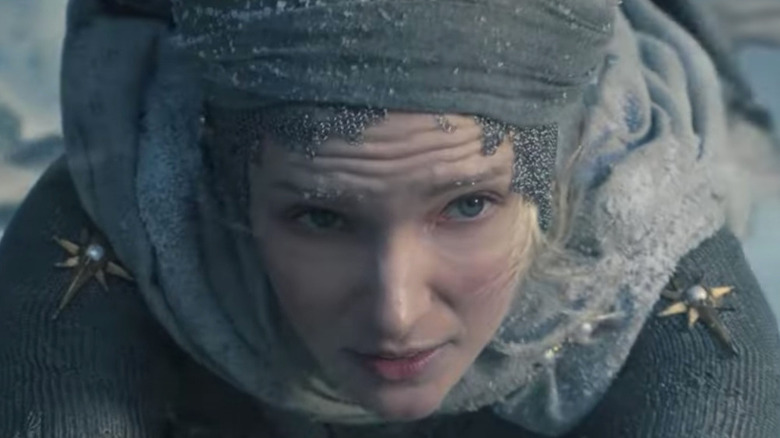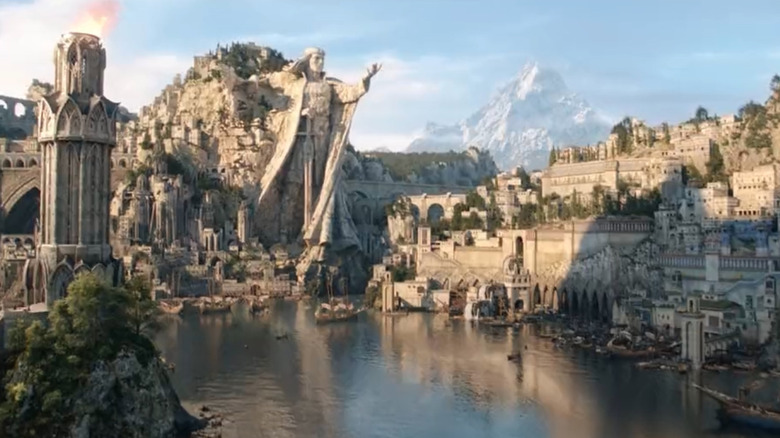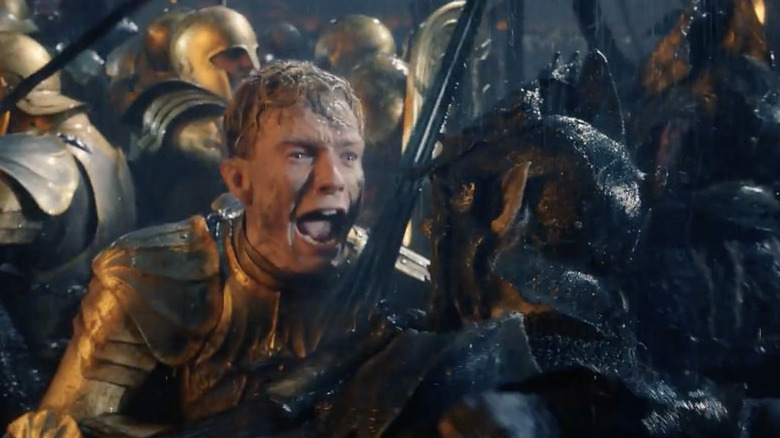Where Does The Rings Of Power Fit In The Lord Of The Rings Timeline?
Amazon Studio's highly anticipated "The Lord of the Rings: The Rings of Power" series promises to be an exciting new chapter of on-screen Middle-earth adventures. The show has been in development for years — ever since the studio bought the rights to portions of "The Lord of the Rings" and "The Hobbit" books back in late 2017, per The Hollywood Reporter – and untried-yet-inspired showrunners J.D. Payne and Patrick McKay have promised to dive deep into Middle-earth lore by exploring a critical part in Tolkien's legendarium: the forging of the Rings of Power, and surrounding events.
This sweeping setting will go far beyond the mere creation of overpowered jewelry, too. Promotional material has consistently hinted at vast storytelling that stretches from the powerful island nation of Númenor in the west to the icy wastes of the Forodwaith in the north, to the toasty Southlands and beyond. The ability to balance multiple story arcs set across such a large area will be one of the showrunners' biggest tasks.
Far-reaching geography isn't the only challenge, though. Time is another concern. Tolkien's world is known for its complexity and richness, much of which comes from its sprawling, intricate history, which the author mapped out for tens of thousands of years. The timeline of "The Rings of Power" technically occurs over a sweeping, 3,500-year stretch of Middle-earth history within that massive chronicled time period. In comparison, the bulk of "The Lord of the Rings" story takes place within the short and sweet time span of a single year. "The Hobbit" is a similarly short story.
The natural question that follows is when does this massive "Rings of Power" timeline take place, and how will it fit into the "Lord of the Rings" history that we all know and love so well?
The Rings of Power will be set in the Second Age
We've known the official timing of "The Rings of Power" for years now. Back in early 2019, the show's official Twitter page announced that it would be focusing on the Second Age. This was exciting, albeit palpitating, news for Tolkien fandom, whom had never had to digest an on-screen adaptation of this early era of Tolkien's world. The larger audience of fair-weather fans, though, didn't know the "Second Age" from Adam.
Since those intriguing pre-pandemic reveals, everyone has started digging into the backstory of this strange new era of Middle-earth, and a few crucial facts have come into focus. First, as already mentioned, the Second Age (per One Wiki to Rule Them All) is nearly 3,500 years long. Second, it comes before the 3,000-year-long Third Age. Third, the "Lord of the Rings" story doesn't take place until the very end of the Third Age. This means the "Rings of Power" story will be playing out between 3,000 and 6,500 years before Gollum topples into the Cracks of Doom, before Frodo gets the One Ring ... heck, before Bilbo is even born.
On top of that, most of the elements of "Lord of the Rings" won't be in place yet. For instance, the resurgent Sauron, in both his Necromancer and "Evil Eye" forms, won't be a thing yet. Gandalf, Saruman, and Radagast, while still alive spiritually, won't be in their incarnate wizarding forms. There isn't a balrog in Moria. Mordor shouldn't even exist yet.
The primary through-lines will be a few immortal elements. This includes people, like Galadriel, Celeborn, and Elrond, places like Rivendell and Gondor (both of which are founded at this time) — and eventually, an earlier, more appealing version of Sauron and his One Ring.
Timing is one of The Rings of Power's biggest risks
While a Second Age story is certainly adaptable, the task is anything but easy. In the case of Peter Jackson's films, there was a large, detailed story to work from, with hundreds of pages of intricate narrative. With "Rings of Power," the bulk of the information Tolkien gave us about the Second Age is disconnected or extremely brief. This may leave a lot of wiggle room, but it also makes it harder to come up with a cohesive cinematic story.
One of the biggest alterations that the show is making to create its narrative has to do with time. In an interview with Vanity Fair in February of 2022, it was revealed that the story was going to condense the entire timeline of the Second Age into a single point in time.
The reason for this staggering change, as pointed out by the showrunners, was to avoid a ton of turnover with their mortal cast. While the point makes sense, condensing the story presents a lot of its own issues. Tolkien strikes a remarkable cadence in his storytelling in spite of the fact that it takes place over hundreds of years. The immense span allows him to set up high stakes that will be hard to replicate in a single story. It also means the show needs to balance a heck of a lot of stories that don't necessarily overlap or run into one another closely in the source material.
McKay and Payne seem to think it's possible to do this successfully. And they have the backing of the Tolkien Estate for their plans. Still, whether or not they can actually pull off this big of a shift is something that only time will tell.


